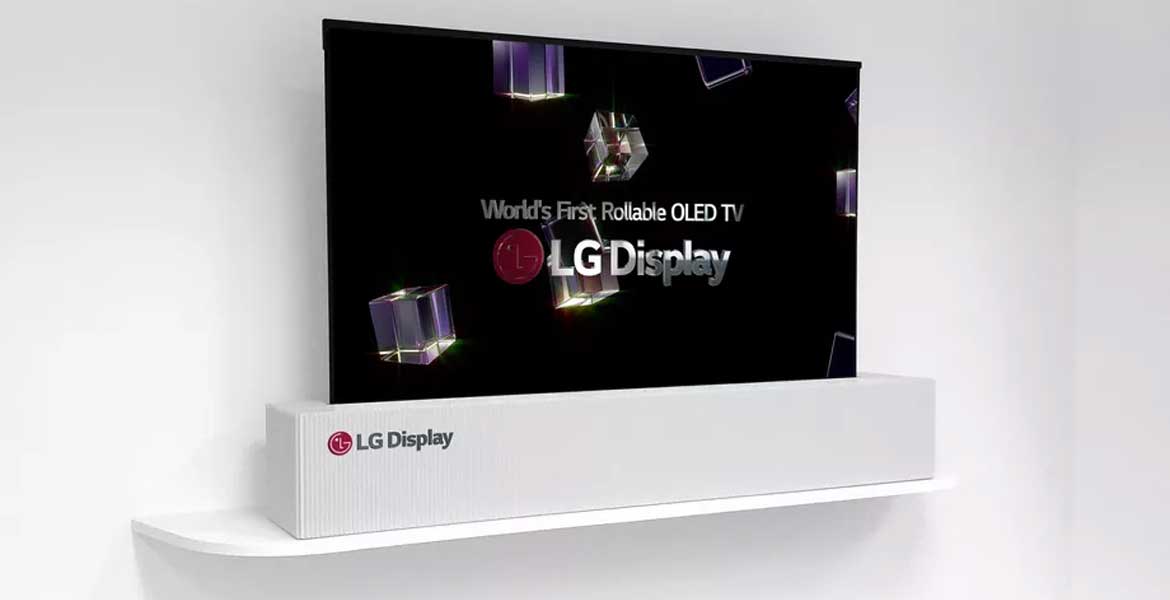A few years ago, LG showcased their new direction in OLED technology: a truly foldable (or rather rollable) display that could be manipulated consistently without losing picture quality or function. Now that it’s 2018, the company has decided to debut what may be the results of considerable development on this concept.
Their CES presentation for this year is dominated by a 65-inch piece of screen technology that appeared to rise from a platform. This is because the impressive display was in fact unrolling upwards; revealing itself to be what could be the world’s first workable foldable TV.
How does it Work?
Conventional large-scale displays operate by illuminating their screens with a backlight, which requires a rigid backing that takes up the entire rear of the display. Therefore, no existing display type, not even the super-thin ‘wallpaper’ screens debuted by LG last year, can be bent to any degree without risking significant damage. This novel display, on the other hand, is a panel of organic LEDs that light up each pixel of the display by themselves. Therefore, the need for a backlight is negated.
The display itself is backed by a segmented arrangement, which allows the screen to be deformed and manipulated more easily. Given that this is an OLED panel, it should allow for true blacks and convincing, saturated colours. However, these predictions will only be realised whenever the rollable display makes it to market.
The Rollable TV: What We May Already Know
The new form of display is stored in a rectangular box, which conceivably houses a cylindrical repository for the display, around which it can coil when not in use. The display can rise from this unit by itself, indicating that is relies on an array of motors or actuators for this purpose. It can also be unfurled to varying degrees, thus offering the user a uniquely wide range of aspect ratios.
Therefore, the display can be very versatile in its applications; for example, the LG staff at CES used it as visual interface for the sonic patterns emanating from a soundbar. The full display appears to be bright, vibrant and saturated, although this is honestly difficult to tell through the medium of video.
Rollable TVs: Potential Pros and Cons
It is kind of obvious that a foldable display may enhance the portability and storage of these appliances. The ‘box’ into which it can fold away when not in use may also boost its durability. This may become an important selling point in terms of real-world rolling display panels. The fact that it can roll and unroll freely indicates that it lacks the usual protective glass with which monitors and televisions are fitted. In fact, the nature of the display’s outer covering is uncertain at this point.
However, we do know (from video coverage of CES 2018 to date) that it creates reflections of a type not normally associated with glass-fronted screens. These reflections, which are most apparent when the flexible display shows dark or dull images, are more murky and indistinct, like those that are gleaned from looking at darkened ‘privacy’ glass or some plastics. Therefore, people who want to buy this new generation of TV in the future may be obliged to treat their screens with more than the usual amount of care and caution.
Besides this possible drawback, the curvable display has a noticeably stark black bar across the top. This, presumably, is an evolution of the thick black cuff with which the 18-inch flexible display that LG demonstrated a few years ago was fitted. This solid bar may house power-cell attachments or other hardware. It may become normal and unobtrusive over time, but people getting used to the display may find it distracting.
Rollable TVs: What We Don’t Know
All the same, the first thing some people may want to know is the amount of their money LG will take for one of these innovative new devices. However, as this is the first generation of a new form of screen technology, this price may not bear thinking about at the moment.
In addition, it is still not clear how LG will manage inputs such as power and display data (e.g. from HMDI connections or TV boxes) for these devices. Furthermore, it is not clear if these devices will rely on soundbars or speakers for their audio outputs, or somehow emit sound themselves.
Finally, it is not known if these displays can come in other (diagonal) sizes – in fact, it is unlikely that they will be available in anything less than 65 inches, unless LG can compress this new technology into more form-factors with considerable speed. Therefore, this may be a concern for people whose main TV rooms may not accommodate something the size of the storage unit for the display as exhibited at the technology event in Las Vegas.
LG may have showed off the future of display technology at this year’s CES showcase. However, these new flexible panels may be out of the reach of most consumers for some time to come. On the other hand, watching the evolution and commercial success of these new, rolling TVs in the meantime should be fun for all.
Top image: LG Display
References
Savov V. LG Display has made a 65-inch rollable OLED TV. The Verge. 2018. Available at: https://www.theverge.com/2018/1/6/16859102/lg-display-rollable-oled-65-inch-ces-2018
Mobile Geeks. 65" Rollable TV by LG Display Demo at CES 2018. Mobilegeeks.de. 2018. Available at: https://www.youtube.com/watch?v=I-gyRiZacp0







No comment